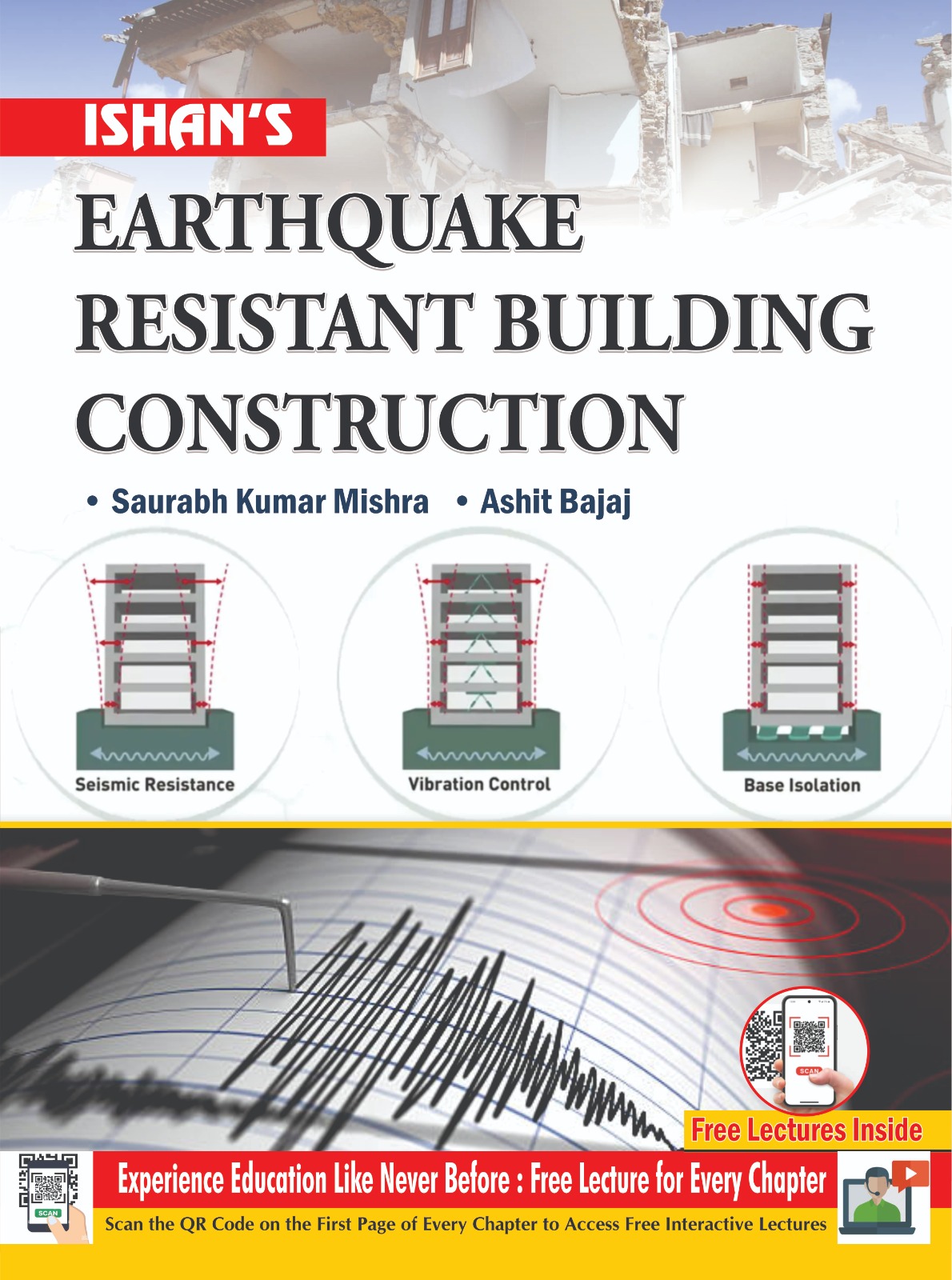
Earthquake Resistant Building Construction
By: Saurabh Kumar Mishra, Ashit Bajaj
ISBN: 978-93-95179-60-7
 Rs.250
10.00% off
Rs.250
10.00% off
Sale Price Rs: 225
DESCRIPTION
Table of Content
For Civil Engineering students
1.
Introduction to Earthquake and earthquake seismology
1.1 Introduction
1.2 What
is an Earthquake?
1.3 Causes
of Earthquake
1.3.1
Tectonic Earthquake
1.3.2 Non-Tectonic Earthquake
1.4 Important
Terms Related to Earthquake
1.5 Seismic Waves
1.5.1
Body Waves
1.5.3 How Seismic Waves are Used in Earthquake
Studies
1.5.4 Seismic Wave Path Through the Earth
1.6 Seismic
Measurement
1.6.1 Nomenclature
1.6.2 Method of Locating
Epicentre of an Earthquake
1.6.3 Method of Earthquake Measurement
1.7 Intensity
of Earthquake
1.8 Seismic
Zones of India
1.9 Static
Loading and Dynamic Loading
1.9.1 Static Loading
1.9.2 Dynamic Loading
Exercise
2. SEISMIC
PERFORMANCE OF STRUCTURE DURING EARTHQUAKES.
2.2 Effect
of Earthquake
2.3 Ground
Shaking Effect on Structures
2.4 Nature
of Stress Due to Seismic Force
2.5 Various
Factors Affecting Damages Due to Earthquake
2.6 Failure
Mechanisms Due to Earthquakes Considering Various Masonry Wall Configurations
2.7 Earthquake
Damage Categories
2.8 Name
of Various Past Earthquake and Their Magnitude
Exercise
3. EARTHQUAKE RESISTANT DESIGN
3.1 Introduction
3.2 Earthquake
Resistant Building
3.3 Earthquake
design Criteria
3.4 Acceptable
Damage
3.5 Concept
of Strong Column and Weak Beam
3.6 Quality
Control in Construction
3.7 Choice
of Design Earthquake
3.8 Oscillations
of Flexible Buildings
3.9 Importance
of seismic design
3.10 How Seismic Forces are Determined
3.11 Assumption for Designing the Building as per IS: 1893-1993
3.12 Load
Combination
3.13 Design
Spectrum as per IS: 1894-2002
Exercise
4. CONSTRUCTION OF EARTHQUAKE RESISTANT MASONRY BUILDINGS
4.1 Introduction
4.2 General Principles of
Earthquake Resistance Building
4.3
General Principles for
Earthquake-Resistant Design and Construction of Buildings (as
per IS:
4326-2013)
4.4
Special Construction
features for Earthquake-Resistant Buildings as per IS: 4326-2013
4.5
Damage and Failure of
Masonry Buildings
4.6 Failure
of Roofs and Floors
4.7 Causes
of Damage in Masonry Buildings
4.8 Behavior
of Brick Masonry Wall
4.9 Strength
of Masonry
4.10 Modes of Failure in
Earthquake-Resistant Buildings
5. MODERN
TECHNIQUES USED IN THE CONSTRUCTION OF EARTHQUAKE RESISTANCE BUILDINGS
5.1 Pneumatic
Systems in Earthquake Resistant Construction
5.1.1
Components of Pneumatic Systems
5.1.2
Working of Pneumatic Systems
5.1.3 Advantages of Pneumatic Systems in
Earthquake Resistant Construction
5.1.4
Limitations
of Pneumatic Systems in Earthquake Resistant Construction
5.2 Base
Isolation as an Earthquake Resistant Technique
5.2.1
Working Principle of Base Isolation
5.2.2 The Concept of Decoupling
5.2.3
Energy Absorption and Dissipation
5.2.4
Reduction of Seismic Force
Transmission
5.2.6
Vertical Load-Bearing Capacity
5.2.7
Pendulum Effect in Advanced Systems
5.3 Seismic Dampers in
Earthquake Resistant Buildings
5.4 Reinforced Concrete
and Steel Frameworks as Earthquake-Resistant Structures
5.5 Advanced
Materials for Earthquake Resistance
5.6 Emerging Techniques
and Technologies
Exercise
6. PLANNING, DESIGNING AND CONSTRUCTION OF EARTHQUAKE RESISTANT BUILDINGS
6.1 Introduction
6.2 Structural
System for Seismic Resistance
6.3 Importance
of Planning and designing in earthquake Resistant Building
6.3.1 Architectural Aspects
6.3.2 Size of Building
6.3.3 Vertical Layout of Building
6.3.4 Adjacency of Buildings
6.3.5 I.S. Specification for Regular and Irregular
Configurations
6.4 Special
Construction Method Tips and Precautions for Earthquake-Resistant
Buildings
7. INTRODUCTION
OF VARIOUS TYPES OF EARTHQUAKE-RESISTANT BUILDING CONSTRUCTION
CODES
7.1 Overview of Earthquake-Resistant
Building Codes in India
7.2 Introduction to Various Earthquake-Resistant Building Construction Codes as per BIS
7.3
Importance of Seismic
Codes in Various Aspects
7.4 Assumptions
Made in IS:
1893-2000 for the Earthquake-Resistant Design of
Structures
7.5 General
Specifications of IS: 13920-1993
7.5.1 Detailing
of Reinforcement as per IS: 13920-1993
7.5.2 Provision
as Per IS: 13920-1993, Precautions for Earthquake for Beam
7.5.3 Detailing of Reinforcement in Column as per
IS: 13920-1993
7.6 General
Principles Considered as per IS: 4326–1993
Exercise
8. seismic provision of strengthening and retrofitting measures for building construction
8.2 Concepts of Repairing, Restoration, Retrofitting and
Strengthening of Existing Structures
8.4 Seismic
Provision of Strengthening
8.5
Seismic Strengthening
Technique
8.5.1 Strengthening R.C. Members
8.5.2 Strengthening of Foundation
8.7 Non-Conventional
Methods of Retrofitting Used for RCC Buildings
8.8 Retrofitting
in Masonry construction: Methods and Techniques
8.9 Retrofitting
in RCC
Structures
Exercise
9. DISASTER MANAGEMENT
9.1 Introduction
to Disaster
9.2 Human
Induced Disasters
9.2.1 Chemical
and Industrial Accidents
9.2.2 Biological
Disasters
9.3 Disaster
Management
9.3.1
Concept of Disaster Management
9.3.2
Functions of Disaster Management
9.3.3
Objectives of Disaster Management
9.3.4
Phases of Disaster Management
9.4 Disaster
Management in India
9.4.1 Disaster
Management Framework in India
9.4.2 National Disaster Management Authority
(NDMA)
9.4.3 National
Institute of Disaster Management (NIDM)
9.4.4 State Disaster
Management Authority (SDMA)
9.4.5 Disaster
Management at Field Level
9.4.6 Private
Sector
9.4.7 Community and Voluntary Agencies
9.4.8 Contribution
of Society Service Organization in Disaster Management
9.4.9 Human
Resources Development
9.4.10 Disaster Awareness
9.4.11 Information, Education and Communication
9.4.12 Disaster Preparedness
9.4.13 Disaster Response and Mitigation Funds
Exercise
10. UNDERSTANDING DISASTER RESCUE, DEBRIS CLEARANCE AND CASUALTY MANAGEMENT IN DISASTER MANAGEMENT
10.1 Introduction to Disaster Rescue
10.3 Psychological
Impact on Victims
10.4 Psychological Support
for Victims
10.5 Psychological
Challenges for Rescue Workers
10.6
Coping Strategies for
Rescue Workers
10.7 Rescue Workers and
Their Role in disaster Rescue
10.8 Roles and
Responsibilities of Rescue Workers
10.9 Rescue Plan in
Disaster Management
10.10 Stages of Rescue in
Disaster management
10.11 Factors Influencing
Rescue Plans and Stages
10.12 Rescue-By-Steps
in Disaster Management
10.13 Factors Influencing Rescue-By-Steps
10.14 Rescue Equipment in
Disaster Management
10.15 Safety in Rescue Operations
10.16 Debris Clearance in
Disaster Management
10.18
Phases of Debris
Clearance
10.19 Percussion Debris
Clearance
10.21
Functions of Casualty
Management
10.22 Classification of Casualties
Exercise
© 2024 All Rights Reserved By ISHAN PUBLICATIONS | Developed & Maintained By Sai Tech Hub, Ambala